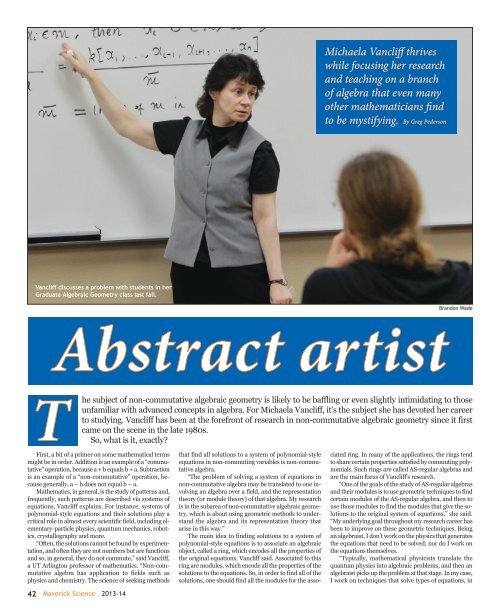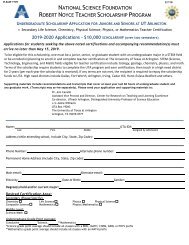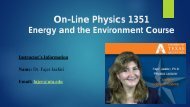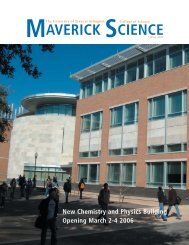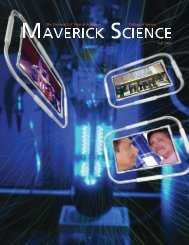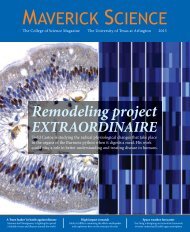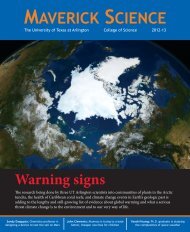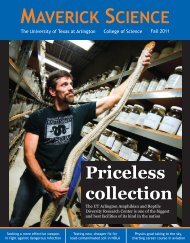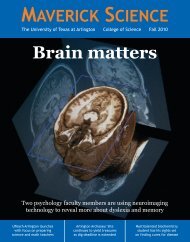Maverick Science mag 2013-14
You also want an ePaper? Increase the reach of your titles
YUMPU automatically turns print PDFs into web optimized ePapers that Google loves.
Michaela Vancliff thrives<br />
while focusing her research<br />
and teaching on a branch<br />
of algebra that even many<br />
other mathematicians find<br />
to be mystifying. By Greg Pederson<br />
Vancliff discusses a problem with students in her<br />
Graduate Algebraic Geometry class last fall.<br />
Brandon Wade<br />
Abstract artist<br />
T<br />
he subject of non-commutative algebraic geometry is likely to be baffling or even slightly intimidating to those<br />
unfamiliar with advanced concepts in algebra. For Michaela Vancliff, it’s the subject she has devoted her career<br />
to studying. Vancliff has been at the forefront of research in non-commutative algebraic geometry since it first<br />
came on the scene in the late 1980s.<br />
So, what is it, exactly?<br />
First, a bit of a primer on some mathematical terms<br />
might be in order. Addition is an example of a “commutative”<br />
operation, because a + b equals b + a. Subtraction<br />
is an example of a “non-commutative” operation, because<br />
generally, a – b does not equal b – a.<br />
Mathematics, in general, is the study of patterns and,<br />
frequently, such patterns are described via systems of<br />
equations, Vancliff explains. For instance, systems of<br />
polynomial-style equations and their solutions play a<br />
critical role in almost every scientific field, including elementary-particle<br />
physics, quantum mechanics, robotics,<br />
crystallography and more.<br />
“Often, the solutions cannot be found by experimentation,<br />
and often they are not numbers but are functions<br />
and so, in general, they do not commute,” said Vancliff,<br />
a UT Arlington professor of mathematics. “Non-commutative<br />
algebra has application to fields such as<br />
physics and chemistry. The science of seeking methods<br />
42 <strong>Maverick</strong> <strong>Science</strong> <strong>2013</strong>-<strong>14</strong><br />
that find all solutions to a system of polynomial-style<br />
equations in non-commuting variables is non-commutative<br />
algebra.<br />
“The problem of solving a system of equations in<br />
non-commutative algebra may be translated to one involving<br />
an algebra over a field, and the representation<br />
theory (or module theory) of that algebra. My research<br />
is in the subarea of non-commutative algebraic geometry,<br />
which is about using geometric methods to understand<br />
the algebra and its representation theory that<br />
arise in this way.”<br />
The main idea to finding solutions to a system of<br />
polynomial-style equations is to associate an algebraic<br />
object, called a ring, which encodes all the properties of<br />
the original equations, Vancliff said. Associated to this<br />
ring are modules, which encode all the properties of the<br />
solutions to the equations. So, in order to find all of the<br />
solutions, one should find all the modules for the associated<br />
ring. In many of the applications, the rings tend<br />
to share certain properties satisfied by commuting polynomials.<br />
Such rings are called AS-regular algebras and<br />
are the main focus of Vancliff’s research.<br />
“One of the goals of the study of AS-regular algebras<br />
and their modules is to use geometric techniques to find<br />
certain modules of the AS-regular algebra, and then to<br />
use those modules to find the modules that give the solutions<br />
to the original system of equations,” she said.<br />
“My underlying goal throughout my research career has<br />
been to improve on these geometric techniques. Being<br />
an algebraist, I don’t work on the physics that generates<br />
the equations that need to be solved; nor do I work on<br />
the equations themselves.<br />
“Typically, mathematical physicists translate the<br />
quantum physics into algebraic problems, and then an<br />
algebraist picks up the problem at that stage. In my case,<br />
I work on techniques that solve types of equations, in


